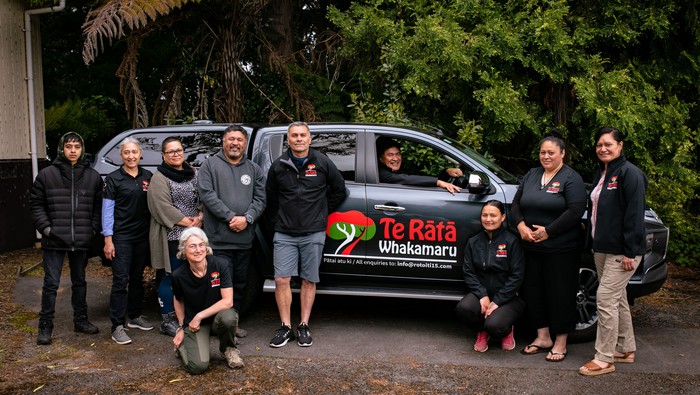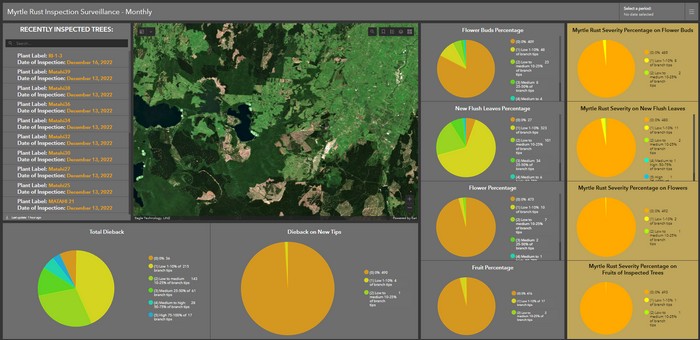Science recruits target myrtle rust species

The Myrtle Rust Jobs for Resistance programme – Te Rātā Whakamaru is a Scion-led project funded by Jobs for Nature/ Mahi mō te Taiao, through the Department of Conservation – Te Papa Atawhai. It is delivered in partnership with Rotoiti 15 Trust. Launched at Te Waiiti Marae at Lake Rotoiti in April 2022, the project is developing knowledge in myrtle rust, working with and for mana whenua.
The programme has 10 full-time staff working for three years in Bay of Plenty native forests and at Scion. Joining with no previous field experience or myrtle rust knowledge, they have been upskilled to monitor the spread of the disease, reporting on tree health and identifying if any trees show signs of resistance.
Arapeta Tahana from Rotoiti 15 Trust says he and his fellow trustees are committed to providing opportunities for the taiao (environment), culture and people.
“This is logical for us to invest in our own people. To increase capacity for learning for our whenua (land) while protecting our ngahere (forests). This is not the sort of work you can outsource,” Tahana says.
“The goal is to provide jobs and build capability within the Bay of Plenty to protect the ngahere against myrtle rust.”
“We are committed to not only understanding the impact of myrtle rust within our environment, but to connect and understand our environment better.”
Scion forest pathologist Julia Soewarto is supporting the team as its project leader. Her focus in the first year has been upskilling the team and mapping sites around the Rotorua lakes area to identify specific locations of known species under threat from myrtle rust.
“Through the winter months the Te Tira Rātā (field work team) worked very hard so we know where the vulnerable host species are around the lakes. We have established monitoring transects at these sites and will keep an eye on them over the 2023 summer to see if they get infected with myrtle rust, and how badly.”
She says it was a pleasure to see the team’s confidence grow as they learnt new environmental monitoring skills.
“In only a few months of training they have become excellent field technicians. We can rely on them to collect comprehensive data from the field.”
Collaboration with the GIS team
Te Rātā Whakamaru has provided additional learning opportunities for Scion’s data and geospatial scientists. They were tasked with developing a phone app that the field team uses to capture photos of species and link them to a GPS location. Captured data can be visualised by Scion’s myrtle researchers on a dashboard so information can be summarised quickly.
Geospatial technician Honey Estarija says the dashboard’s value was priceless.
“We learnt a lot as we worked through various technical challenges, and these are things that will not be forgotten as we can apply them to future projects.
“The importance of this app has already been recognised by others and we’ve been asked to help them create something similar for their projects.”
Within the first four months of using the technology, the field team identified more than 3,000 trees that are vulnerable to myrtle rust around the
Rotorua lakes.
“We knew the places they were surveying would identify some, but every time they went into the field, they captured more,” says Soewarto.
“This is very valuable information as it increases our knowledge about the native species.”
Sharing knowledge
Te Rātā Whakamaru is unique. Its science focus means that the team is not only working in the forests but is also exposed to Scion’s laboratories and nursery. As part of their job, they are being upskilled in several areas of forest biosecurity science.
They are also developing new educational resources.
“These are the types of resources that can be shared with mana whenua, or anyone interested in learning how to identify these plant species,” Soewarto says.
Kerri Anne Hancock, Tauwharenga (general manager) for Rotoiti 15 Trust says they really value the partnership.
“It’s a good example of what magic can be achieved when CRIs and tāngata whenua come together and combine our experience and knowledge to protect our taiao. I’d love to see more partnerships like this in the future.”
This partnership is part of the nationwide Jobs for Nature $1.129 billion programme led by the Department of Conservation and the Ministry for the Environment to revitalise communities through nature-based employment. Its primary focus is to support businesses to provide employment as the economic impacts of Covid-19 unfold while ensuring environmental benefits.
Scion portfolio leader Heidi Dungey says while this work will not prevent infections, it will help with understanding of when and where the most susceptible myrtle species are within the region and provide ways to support them.
“We can also identify the most resistant trees and work out what helps them stay healthier while others around them may succumb to the disease,” she says.
“Cuttings will be taken and seed collections started with the intention of co-developing a resistance breeding programme with our partners.”
For more information, please contact Heidi Dungey

